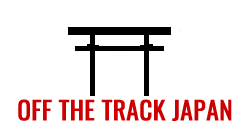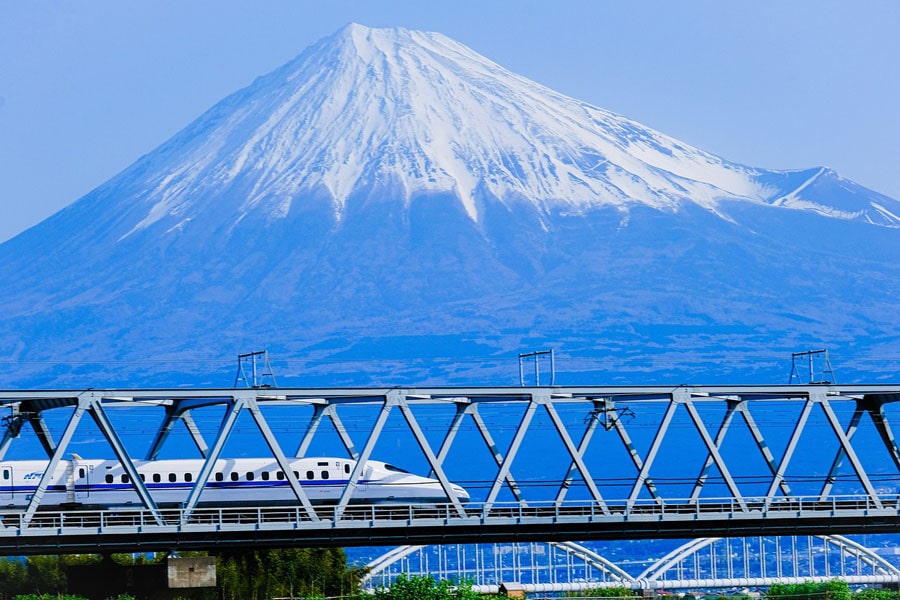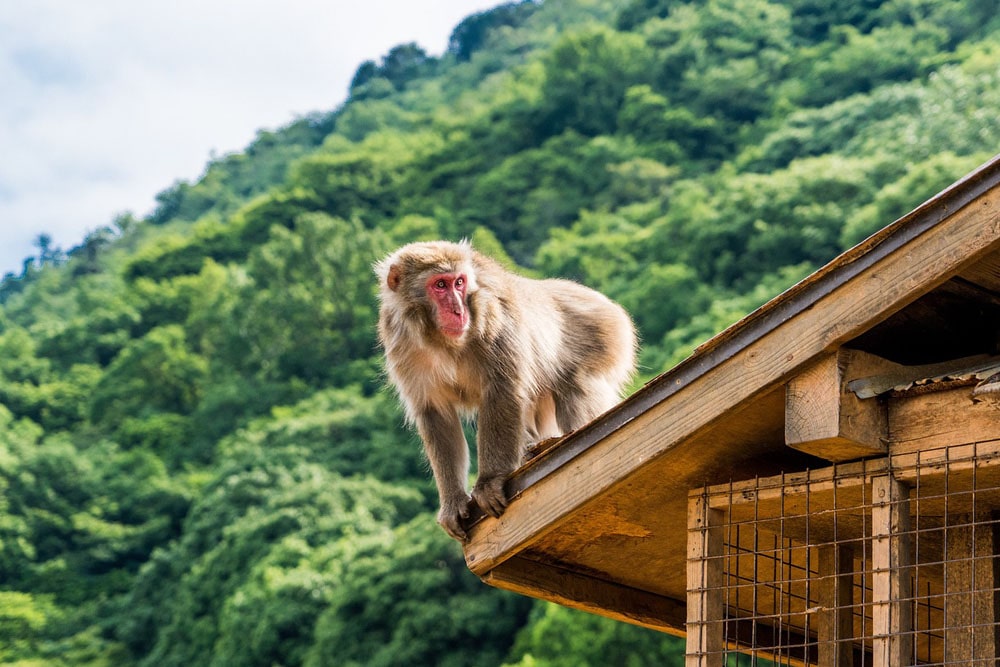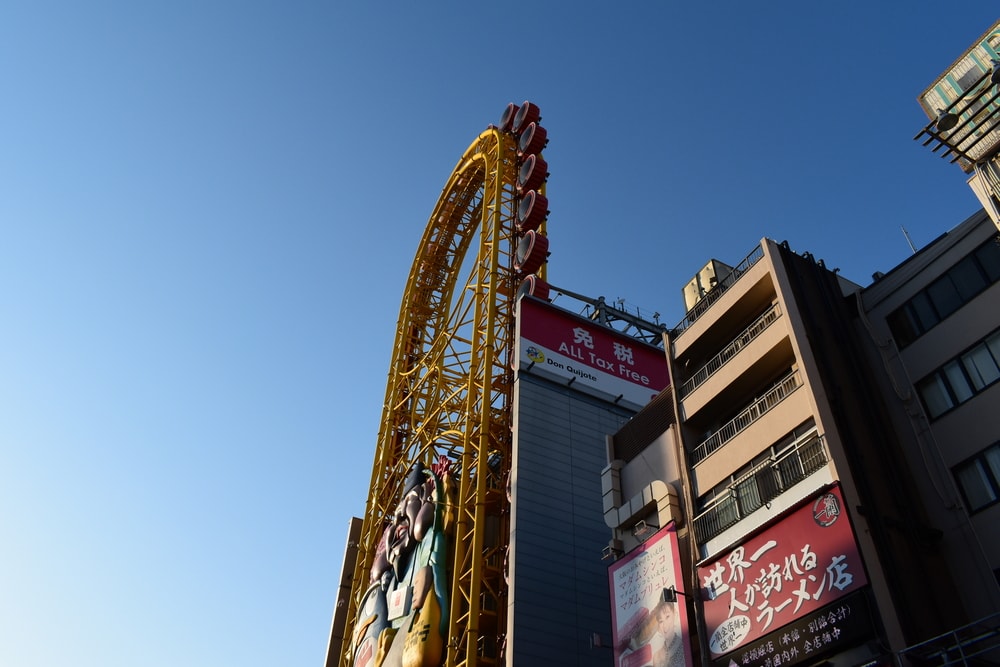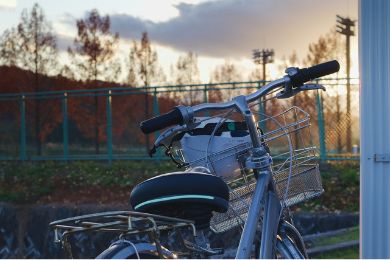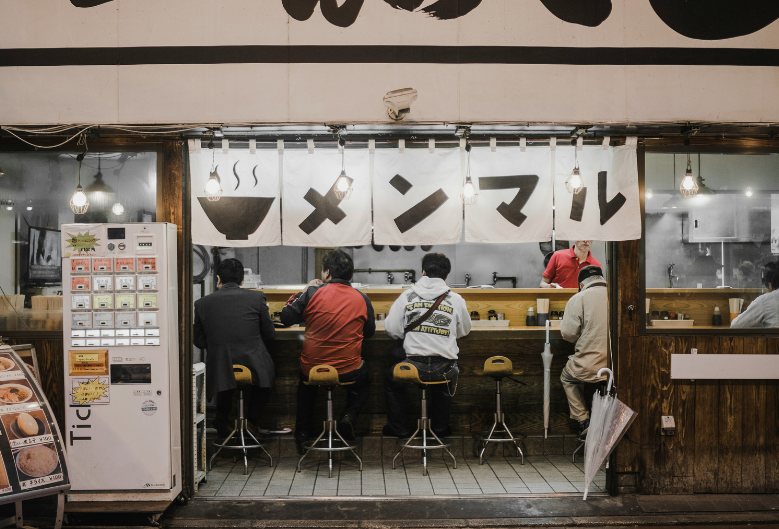
Japan is renowned for its world-class cuisine. But as someone who has food allergies, travelling to Japan can be a challenge, particularly if you don’t speak Japanese very well. If you have food allergies, navigating a Japanese menu can be a minefield, with many potential allergens hiding in the dish.
In this guide, we’ll aim to help you navigate Japan with food allergies, so that you, too, can indulge in Japan’s world-famous cuisine.
*Note: This article is intended as information only. We advise that you do further research, as each restaurant may use different recipes that differ from the norm.
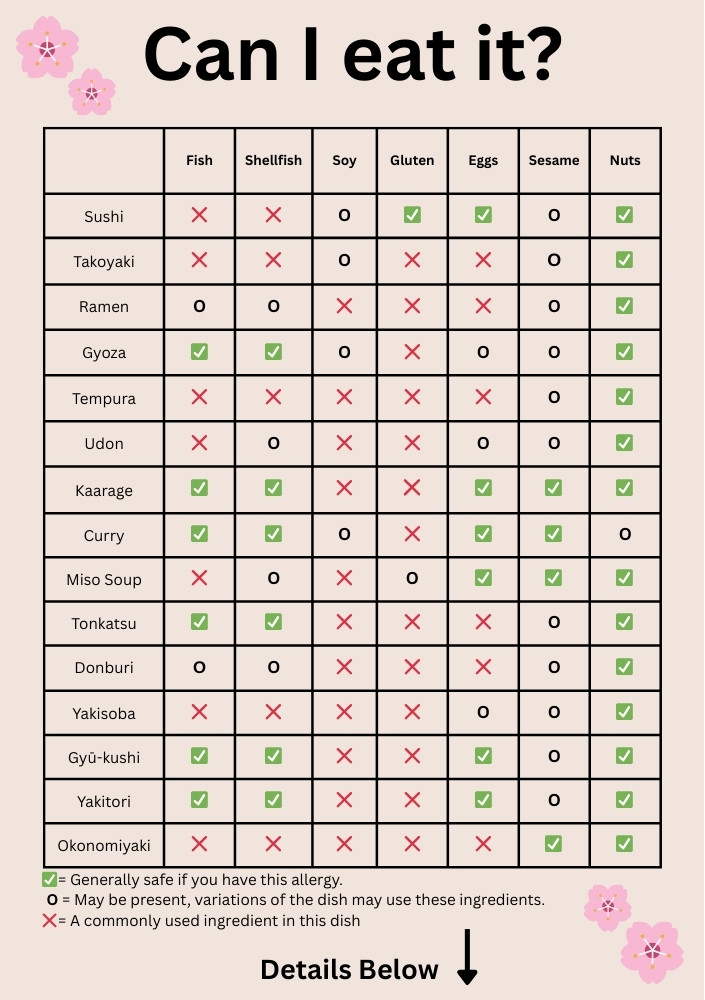
Further Detail
Sushi is made with vinegared rice paired with ingredients such as fresh fish, shellfish, vegetables, egg, or seaweed. It can be served as hand-pressed nigiri, rolled maki, or simple sashimi with rice.
Sushi, and dishes in the sushi family (Eg. Sashimi, Nigiri, etc.) They are typically prepared with fish, shellfish, and other seafoods. Unlike western variations of sushi, there is much fewer chicken sushi options.
⚠️In Sushi, the Allergens to look out for are:
Fish: Typically, most sushi has fish or seafood as the primary source of protein. Dashi, or fish broth, is also commonly added to Tamagoyaki – the Japanese omelette, also a common topping for sushi.
Seafood /Shellfish: Other standard toppings in Sushi include Shrimp, octopus, crab, and more.
Soy: Can be avoided to an extent. Soy sauce is a common dipping sauce for sushi. Additionally, it may be added as a glaze or marinade for some preparations. It’s best to find dishes with no sauce on them, and avoid dipping your sushi in soy sauce.
Eggs: While not commonly an allergen in Sushi, there is a variation of sushi that uses a Japanese omelette (typically contains dashi) instead of fish. If you are allergic to fish or eggs, then avoid Tamagoyaki Sushi.
Sesame: Sesame is a relatively uncommon garnish or sauce accompanying sushi. However, it may be present depending on the location and restaurant.
Takoyaki, translated to Grilled octopus and sometimes referred to as ‘Octopus Balls’are savoury bite-sized balls consisting of batter, spring onion, and typically octopus. There are variations of takoyaki, which include cheese, fish, shrimp, and other seafood.
⚠️In Takoyaki, the Allergens to look out for are:
Fish: Dashi, or Fish stock, is typically used when preparing the batter. Furthermore, Bonito fish flakes are added as a garnish after preparing.
Shellfish / Seafood: Shellfish and other seafoods are common ingredients when preparing Takoyaki. Best to avoid altogether if you have a seafood or shellfish allergy.
Soy: Takoyaki sauce, traditionally smothered over the freshly cooked takoyaki, contains soy. Aside from the sauce, the dish is commonly soy-free. You may be able to request no sauce on your Takoyaki if you have a Soy Allergy.
Gluten: Flour is a core ingredient in Takoyaki batter, and therefore will contain gluten.
Eggs: Eggs are another core ingredient of Takoyaki batter.
Sesame: Sesame is sometimes added to sauces or as a garnish. The use of sesame may vary by location, but the dish doesn’t typically don’t contain sesame.
Ramen is a noodle soup made with wheat noodles served in a rich broth flavored with soy sauce, miso, or pork bones. It is typically topped with sliced pork, egg, seaweed, green onions, and vegetables.
⚠️In Ramen, the Allergens to look out for are:
Fish: Dashi, or fish broth, is sometimes added to ramen broth for an extra umami hit. It may be present in small quantities. Additionally, some bowls are garnished with fish cakes like narutomaki, which are white with a pink swirl through them (like this🍥). If you have a severe allergy to fish, then exercise caution with ramen.
Shellfish & Seafood: Sometimes used in the broth for Umami. Rare, but not impossible to come across.
Soy: Soy is a key ingredient in most ramen preparations, particularly miso broths, but is common in Shoyu (Soy sauce) and Shio (Salt) style broths too. Soy sauce is also typically used to marinate eggs used as a topping for ramen.
Gluten: Flour is used to make the noodles. Soy sauce is also commonly used in ramen preparation.
Eggs: Eggs are used in the noodles, and are commonly a topping in most ramen bowls.
Sesame: Occasionally used in the broth, oils, garnish or marinades.
Gyoza is a popular dumpling consisting of pork mince, ginger, garlic, and cabbage. A fan favourite side-dish for ramen, or a quick bite in itself.
⚠️In Gyoza, the Allergens to look out for are:
Fish & Seafood: Most gyoza are Pork and cabbage. However, you may come across different varieties of Gyoza, and some may contain shrimp or other seafood. However, in most cases, Gyoza is pork and cabbage unless stated otherwise.
Soy: Gyoza typically come with a dipping sauce, a mixture of soy sauce and rice vinegar. The sauce elevates the flavours of the gyoza, but is an optional dipping sauce so Gyoza can still be enjoyed without it.
Gluten: As gyoza are dumplings, the wrapping is often made from a base of flour. Some restaurants may also use flour in the mixture to thicken it slightly.
Eggs: Typically not part of the gyoza dough recipe. There may be the odd recipe or restaurant that uses egg, but they are an uncommon practice.
Sesame: Much like soy, Sesame oil or seeds may be used to enhance the flavour of the dipping sauce, or as a garnish. In most cases, you can easily avoid sesame when eating Gyoza.
Tempura is a general term for either seafood or vegetables coated in a light, flaky batter and fried until soft yet crispy. Originally Portuguese, Tempura has become a staple of Japanese cuisine.
⚠️In Tempura, the Allergens to look out for are:
Fish: Dashi is sometimes used as a base for soups or dipping sauces when paired with Tempura. If you are just eating tempura vegetables without any dipping sauce, then you should be OK.
Shellfish & Seafood: A common preparation of tempura is Tempura Shrimp. If you have this allergy, then stick to the vegetarian tempura.
Gluten: Flour is used to form the tempura batter, and is also sometimes used in sauces. It is likely an unavoidable ingredient.
Eggs: Eggs are also used in the preparation of the batter. While some variations exist without eggs, eggs are primarily used in most places.
Udon is a versatile, thick and bouncy noodle. Served hot, cold, and numerous other preparations, Udon is an underrated favourite among tourists.
⚠️In Udon, the Allergens to look out for are:
Fish: Udon noodles themselves are made without fish. However, a lot of soups, sauces, and other pairings with Udon contain fish. Unless you want plain udon noodles, it is unlikely that you can eat udon with a fish allergy. Udon noodles can be enjoyed plain, but the sauces highly elevate the taste and texture of the dish.
Shellfish: Much like fish, Udon doesn’t inherently contain shellfish. However, one of the most popular bowls of Udon is Tempura Udon, which typically contains tempura shrimp, or other similar shellfish. It can however, be avoided.
Soy: Soy sauce is a common ingredient in udon noodle broths, as well as a dipping sauce for cold preparations. Udon noodles can be enjoyed plain, but the sauces highly elevate the taste and texture of the dish.
Gluten: Udon noodles are made using flour, and Udon broths typically are soy sauce-based. Therefore, if you have a gluten allergy, then udon may not be possible to eat.
Eggs: Eggs are a common topping for udon soups, and can also be used in other toppings like Tempura.
Sesame: A fairly uncommon garnish or ingredient, but can sometimes be used.
Karaage is known as Japanese Fried Chicken – a popular side dish or a quick bite at any time of the day. They can be found at convenience stores, to Japanese pubs, to street vendors.
⚠️In Kaarage, the Allergens to look out for are:
Soy: Often used as part of the marinating process to make the meat more tender. It’s hard to avoid.
Gluten: Flour is used to coat the chicken pieces before frying, as well as gluten can also be found in the soy sauce marinade.
Egg: While not it directly part of the Kaarage, a common topping for Kaarage is Mayonaise, but it can easily be avoided.
- Sesame: Sometimes used in the oil, or as a garnish. Varies by location, but isn’t the most common practice.
Japanese curry is rich and full of flavour. Served throughout the country, Japanese curry is a perfect hearty meal no matter the time of year.
⚠️In Japanese Curry, the Allergens to look out for are:
Soy: Often used in the curry roux and difficult to avoid.
Gluten: Used to thicken up the curry roux.
Nuts: Sometimes used to enhance the flavour of the curry roux. Found in small quantities, Japanese curry is often safe for those with nut allergies.
Miso soup is a delicious side dish, often served alongside traditional Japanese breakfasts or Kaiseki meals.
⚠️In Miso Soup, the Allergens to look out for are:
Fish: Dashi is used commonly used to enhance the flavour of the broth. It is typically found in small quantities in the dish, as Miso soup is primarily miso paste, water and seaweed.
Shellfish: Some restaurants include clams or other seafood like shrimp in their dashi for enhanced flavour. Check with the restaurant first if you have concerns.
Soy: Soy beans are the primary ingredient used when making Miso paste. As such, those with Soy allergies can not have Miso Soup.
Gluten: Some varieties of Miso soup use soy sauce to enhance the flavours. However, this is relatively uncommon.
Tonkatsu, or pork cutlet, is a popular dish enjoyed throughout Japan. Thick, juicy cuts of pork are dunked in an egg wash, and covered in panko breadcrumbs, then cooked to perfection.
⚠️Allergens to look out for in Tonkatsu are:
Soy: Used in the Tonkatsu sauce, and sometimes in the marinades.
Gluten: The pork cutlet is dipped in flour before cooking. Additionally, Tonkatsu sauce contains soy sauce.
Eggs: Used as the egg wash for breading.
Sesame: Tonkatsu is usually served with Cabbage. An everyday dressing that pairs nicely with cabbage is a sesame sauce. It can be avoided.
Donburi is a general term that refers to rice bowls, with numerous topping combinations, from katsu, to a pile of thinly sliced beef.
⚠️In Donburi, the Allergens to look out for are:
Fish: Dashi is often used to form a loose broth that soaks into the rice bowl. You may be able to request your bowl without broth. Additionally, you can also find fish donburi which has fresh fish piled atop the rice.
Shellfish & Seafood: Seafood bowls are commonly enjoyed in coastal areas. If you are allergic to Shellfish or seafood, then avoid these bowls.
Soy: Soy sauce is commonly used in marinades for meat, used in sauces for the toppings, and sometimes in the rice bowl broth itself.
Gluten: The soy sauce-based sauces or broths used in Donburi will likely contain gluten. Additionally, any breaded/fried toppings will also contain gluten.
Eggs: Eggs are commonly used as toppings, either boiled, scrambled, raw, or used as a binding agent in fried toppings. Their presence depends on the type of bowl.
Sesame: Sometimes used in the oils, or garnish.
Yakisoba is a dish consisting of stir-fried noodles, a meat/protein of choice, and various mixed vegetables. The dish is lathered in yakisoba sauce, which is absorbed into the noodles.
⚠️In Yakisoba, the Allergens to look out for are:
Fish: Fish is not a core ingredient of the dish, but is often found in small quantities in the sauce, either in the form of Worcestershire sauce or dashi. Those who experience mild reactions to fish may be able to consume Yakisoba as the presence is small by comparison. It may be possible to order without sauce.
Shellfish & Seafood: Oyster sauce is another core component of Yakisoba sauce. It may be possible to order without sauce if you have an allergy.
Soy: Soy sauce is commonly used in Yakisoba Sauce, as well as other toppings.
Eggs: Sometimes used in the noodles, but relatively uncommon.
Gyu Kushi, or beef skewers, are a popular street food. Thin cuts of steak are skewers, cooked over a grill, and then lathered with a salty sauce, a perfect snack for on the go.
⚠️With Gyu Kushi, the Allergens to look out for are:
Soy: Used for the sauce added on after being cooked, as well as in most marinades.
Gluten: From the soy sauce and other dressings used during preparation
Sesame: Sometimes used in the sauces or dressings
Yakitori is a popular street food, or enjoyed at Japanese Izakaya. Chicken is skewered and covered with sauce. The chicken is then delicately cooked over a fire grill.
⚠️Allergens to look out for in Yakitori are:
Soy: Tare sauce, typically lathered on yakitori, is soy-sauce-based. Shio, or Salt yakitori, can be consumed safely.
Gluten: Tare sauce, typically lathered on yakitori, is soy-sauce-based. Shio, or Salt yakitori, can be consumed safely.
Sesame: Occasionally used as a cooking sauce, or dipping sauce.
Okonomiyaki is a savoury pancake dish popular in Japan as both a restaurant food, a home-cooked meal, or a street food. The dish typically consists of a protein of choice, cabbage, eggs, and other vegetables, and is then covered in Okonomiyaki sauce and Mayonnaise.
⚠️Allergens to look out for in Okonomiyaki are:
Fish: Bonito flakes are used as a garnish after the dish has been cooked. It is possible to order without bonito flakes. Dashi may also be used in the pancake batter in small quantities. Worcestershire sauce may also be used to make the okonomiyaki sauce.
Seafood: Seafood is a popular protein of choice for Okonomiyaki, including shrimp and oysters. Also, oyster sauce is a common ingredient in Okonomiyaki Sauce.
Soy: Used in the preparation of okonomiyaki sauce.
Gluten: Flour is used to make the batter.
Eggs: Eggs are used to make the batter, as well as used in the mayonnaise topping.
Food FAQs
To say that you have a food allergy, say the following.
私は食べ物アレルギーがあります。
(Wa-ta-shi wa ta-be-mo-no a-re-ru-gi ga ari-mas.)
[Allergen] は食べません。
[Allergen] wa tabemasen
Common Allergens
- Soy (大豆, dai-zu)
- Wheat (小麦, ko-mu-gi)
- Egg (卵, ta-ma-go)
- Milk/Dairy (乳, nyū)
- Fish (魚, sa-ka-na)
- Shellfish (甲殻類, kō-ka-ku-rui)
- Seafood (シーフード, shi-fu-do)
- Buckwheat (そば, soba)
- Sesame (ごま, goma)
- Peanuts (落花生, rakkasei)
- Tree nuts (ナッツ, nattsu)
Yes, it is for allergy purposes, but the request may not be able to be accommodated all the time. Typically, restaurants in Japan have issues with substitutions for preferences, not allergies. Here are some helpful tips:
Be direct and upfront about the allergy.
In Japan, “preferences” (like disliking a taste) are often seen differently from allergies. If it’s a true allergy, make that very clear. Tell the staff that you have an allergy, and don’t be afraid to use Google Translate to assist with the ordering process.
Broths and marinades are not usually possible.
Broths and marinades are usually prepared well before the restaurant opens. As such, there is limited flexibility in what can be done in this space. Toppings like sauce drizzles, garnishes, etc., are more than likely to be accommodated.
Chain restaurants vs. small shops. Larger chains (like ramen shops, curry houses, and fast food) often publish allergen charts and can be safer for substitutions. Small mom-and-pop places may not be flexible because their recipes are fixed.
Alert the restaurant staff right away and ask for them to call the emergency services for you.
If you are alone, then dial 119, or find the nearest hospital.
We highly recommend getting travel insurance that covers allergic reactions if you are at risk of an allergic reaction
Explore Japan
Top Content
Japan Rail Pass | Travel Tips
Unlock Japan with the Japan Rail Pass
Iwatayama Monkey Park
See Japanese Macaque Monkey's in Kyoto City
Where to Store Luggage in Japan
Your guide to travelling Japan unincumbered
Dotonbori Ferris Wheel
Unique view of Dotonbori
Dōtonbori
Osaka's Vibrant Canal District
More Travel Tips
Disclaimer: This page is intended for information purposes only. Due to the individual preparation styles of the dishes around Japan, Off The Track Japan (Miruzu Travel Group), can not guarantee that any of the dishes listed in this article will be safe to consume if you have a food allergy. It is the readers responsibility to ensure with the restaurant, store, stall, or food truck that any food meets their dietry requirements. Off The Track Japan (Miruzu Travel Group) accepts no responsibility for any allergic reactions, injuries, or deaths caused by information in this article.
